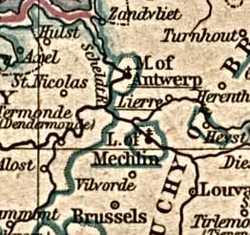
Back لوردية ميشيلين Arabic Senyoria de Mechelen Catalan Herrlichkeit Mechelen German Seigneurie de Malines French Signoria di Malines Italian Heerlijkheid Mechelen Dutch Dominium Mechelen NB Senioria Mechelen Romanian Мехелен (сеньория) Russian
This article needs additional citations for verification. (March 2023) |
Lordship of Mechelen | |||||||||||||
|---|---|---|---|---|---|---|---|---|---|---|---|---|---|
| 910–1795 | |||||||||||||
The coat of arms of the Lordship of Mechelen: in 1490, the Emperor Frederick III authorized the addition of the eagle.[1]
| |||||||||||||
 The seigneury of Mechelen around Lordship in 1350 | |||||||||||||
 Map of the area from 1559–1608 | |||||||||||||
| Status |
| ||||||||||||
| Capital | Mechelen | ||||||||||||
| Common languages | Dutch | ||||||||||||
| Religion | Catholicism | ||||||||||||
| Government | Feudal Lordship, Principality, Heerlijkheid | ||||||||||||
| Lord of Mechelen | |||||||||||||
• ??? | Huis Berthout | ||||||||||||
| Historical era | Middle Ages, Early Modern Period, French Revolution | ||||||||||||
• foundation and First mention of the Berthouts as lords of Mechelen. | 11th century | ||||||||||||
• Charles III Simple gives the abbey of Mechelen to the bishop of Liège. | 910 | ||||||||||||
• Entry for the first time the dominion of Burgundy and The Prince-Bishopric of Liège cedes Malines to the Count of Flanders. | 1333 | ||||||||||||
• Obtaining county status | 1490 | ||||||||||||
• The Eighty Years' War | 1568 | ||||||||||||
• The French Revolutionary Wars and The seigniory is incorporated into the department of Deux-Nèthes. | 1795 | ||||||||||||
| |||||||||||||
| Today part of | Belgium Antwerp Province | ||||||||||||
The Lordship of Mechelen or Malines[2][3] (Dutch: Heerlijkheid Mechelen, French: Seigneurie de Malines) was a small autonomous Lordship in the Low Countries, consisting of the city of Mechelen and some surrounding villages.[4] It lasted from 910 to 1795.
- ^ A Lintz le 10 janvier 1490. Lettres patentes de l'empereur Frédéric, par lesquelles il élève au rang de comté la ville de Malines et son district [...]. Il accorde en même temps à la ville qu'elle puisse placer, dans l'écu de ses armes, une aigle noire aux ailes déployées, en la même forme et manière qu'elle est dans les armoiries des rois des Romains. (En latin)
Collection de documens inédits concernant l'histoire de la Belgique : tome second / publié par L.P. Gachard. - L. Hauman et comp., 1834, p.46. - ^ Munro, J.H. (2015). Money in the Pre-Industrial World: Bullion, Debasements and Coin Substitutes. Taylor & Francis. p. 69. ISBN 978-1-317-32191-0.
- ^ Darby, Graham (2003). The Origins and Development of the Dutch Revolt. Taylor & Francis. p. 7, footnote 5. ISBN 978-1-134-52483-9.
- ^ The Hundred Years War (Part III): Further Considerations. Brill. 2013. p. 480. ISBN 9789004245655.
![The coat of arms of the Lordship of Mechelen: in 1490, the Emperor Frederick III authorized the addition of the eagle.[1] of Lordship of Mechelen](http://upload.wikimedia.org/wikipedia/commons/thumb/f/f6/Escudo_de_Malinas_1581.svg/85px-Escudo_de_Malinas_1581.svg.png)